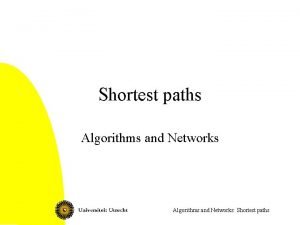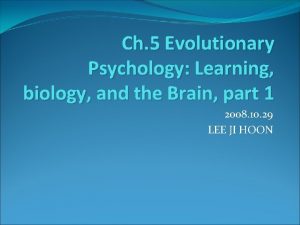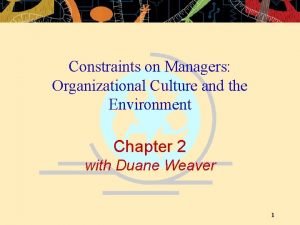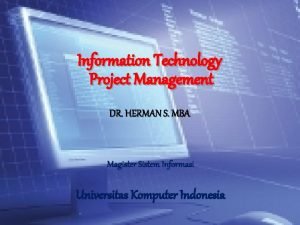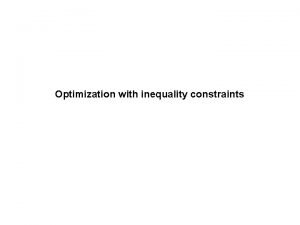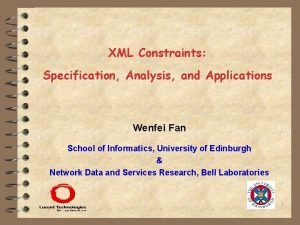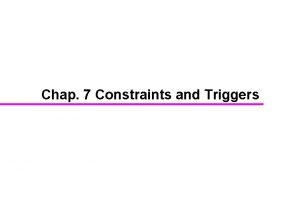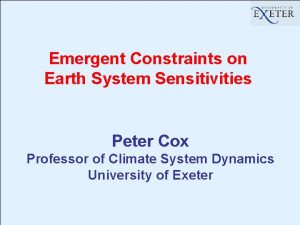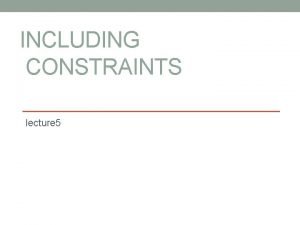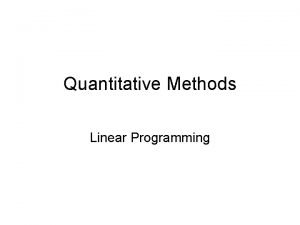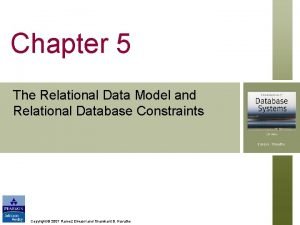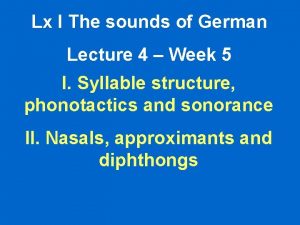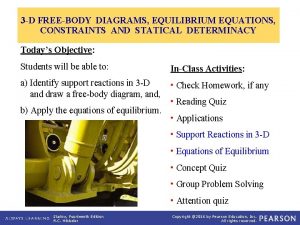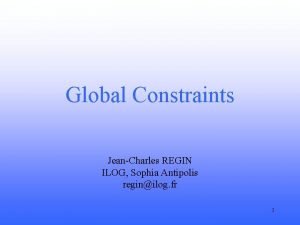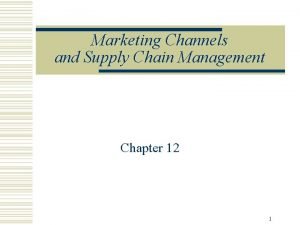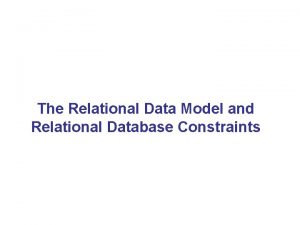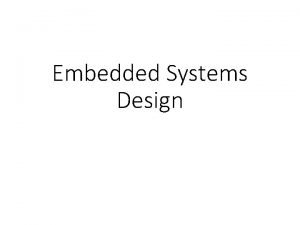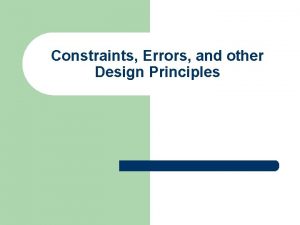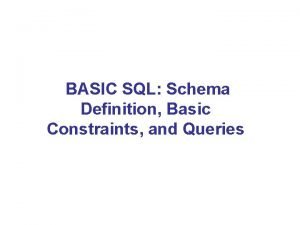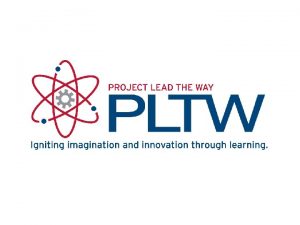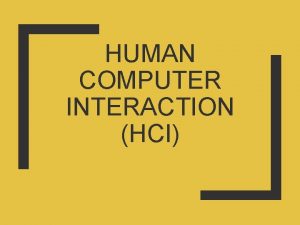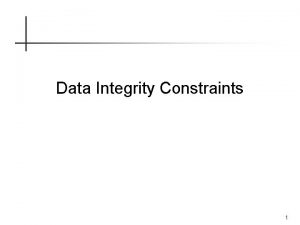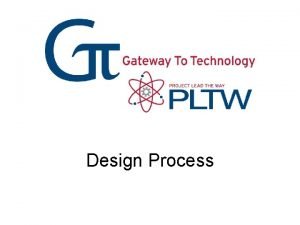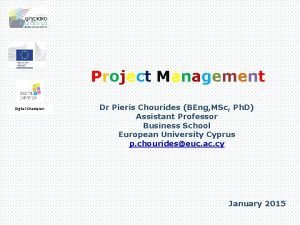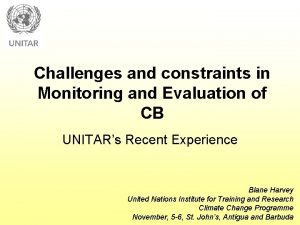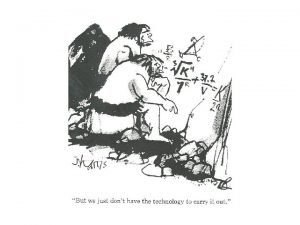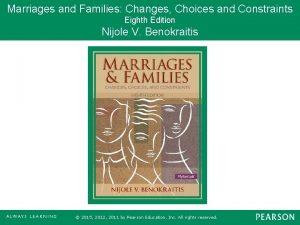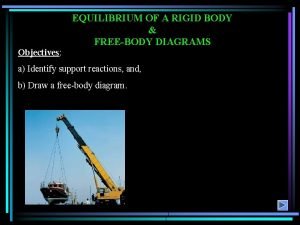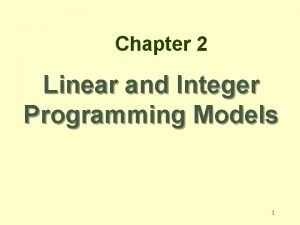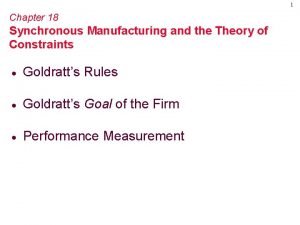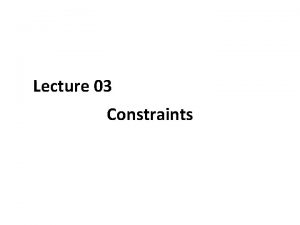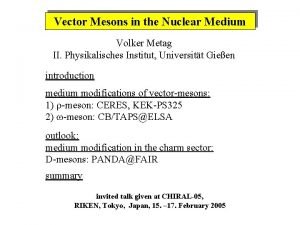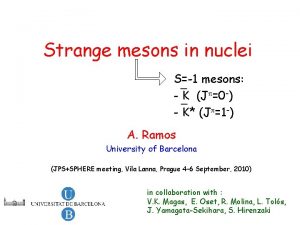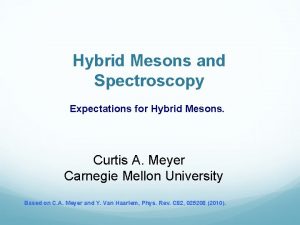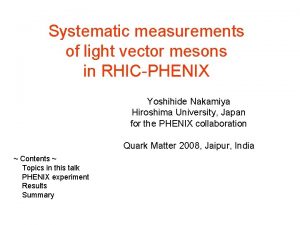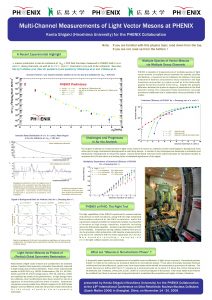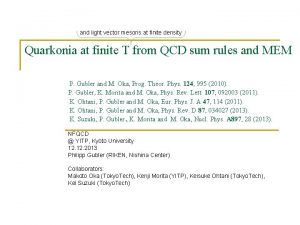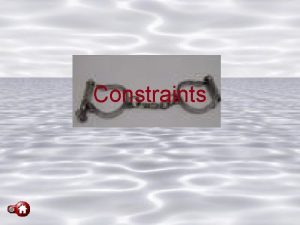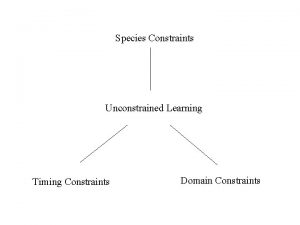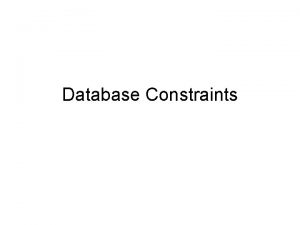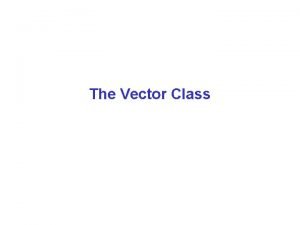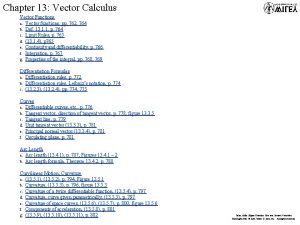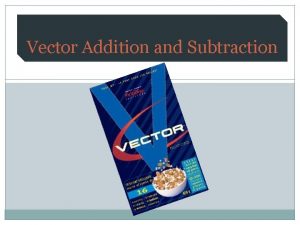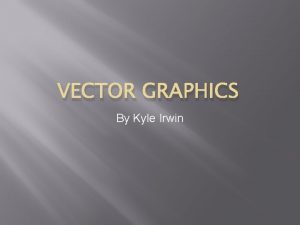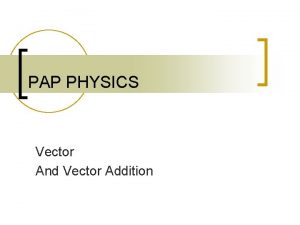Light Vector Mesons in Medium From Constraints to

























![4. 7 Intermediate Mass: “Chiral Mixing” [Dey, Eletsky +Ioffe ’ 90] • low-energy pion 4. 7 Intermediate Mass: “Chiral Mixing” [Dey, Eletsky +Ioffe ’ 90] • low-energy pion](https://slidetodoc.com/presentation_image_h2/0e27adcc2ce1161370da7b289b5970ed/image-26.jpg)






![6. 1. 2 Bulk Hadron Observables: Fireball Model [van Hees et al ’ 11] 6. 1. 2 Bulk Hadron Observables: Fireball Model [van Hees et al ’ 11]](https://slidetodoc.com/presentation_image_h2/0e27adcc2ce1161370da7b289b5970ed/image-33.jpg)








![6. 4 Summary of EM Probes at SPS In(158 AGe. V)+In Mmm [Ge. V] 6. 4 Summary of EM Probes at SPS In(158 AGe. V)+In Mmm [Ge. V]](https://slidetodoc.com/presentation_image_h2/0e27adcc2ce1161370da7b289b5970ed/image-42.jpg)







![4. 3. 3 Acceptance-Corrected NA 60 Spectra [van Hees + RR ‘ 08] • 4. 3. 3 Acceptance-Corrected NA 60 Spectra [van Hees + RR ‘ 08] •](https://slidetodoc.com/presentation_image_h2/0e27adcc2ce1161370da7b289b5970ed/image-50.jpg)
![4. 5 EM Probes in Central Pb-Au/Pb at SPS Di-Electrons [CERES/NA 45] Photons [WA 4. 5 EM Probes in Central Pb-Au/Pb at SPS Di-Electrons [CERES/NA 45] Photons [WA](https://slidetodoc.com/presentation_image_h2/0e27adcc2ce1161370da7b289b5970ed/image-51.jpg)



- Slides: 54

Light Vector Mesons in Medium: From Constraints to Predictions Ralf Rapp Cyclotron Institute + Dept. of Physics & Astronomy Texas A&M University College Station, Texas USA EMMI RRTF Symposium “Emissivity of Matter under Extreme Conditions: l+l- + c. S” GSI (Darmstadt, Germany), 09. 10. 13

1. ) EM Spectral Function + QCD Phase Structure • Electromagn. spectral function - √s ≤ 1 Ge. V : non-perturbative - √s > 1. 5 Ge. V : pertubative (“dual”) e+e- → hadrons ~ Im Pem / M 2 • Modifications of resonances ↔ phase structure: hadronic matter → Quark-Gluon Plasma? • Thermal e+e- emission rate from hot/dense matter (lem >> Rnucleus ) Im Πem(M, q; m. B, T) • Temperature? Degrees of freedom? • Deconfinement? Chiral Restoration? √s = M

Outline 2. ) Axial-/Vector Mesons in Vacuum - Massive Yang-Mills - Observables + Sum Rules 3. ) Vector Mesons in Medium + Constraints - Hadronic Many-Body Theory - p. N→r. N, g. N/A Absorption 4. ) Predictions I: Cold Matter - g. N/A → e+e-N/A - w Spectral Function 5. ) Theoretical Tests in Medium - Sum Rules - Lattice-QCD 6. ) Predictions II: Hot Matter 7. ) Conclusions

2. ) Axial/Vector Mesons in Vacuum Introduce r, a 1 as gauge bosons into free p +r +a 1 Lagrangian p r propagator: • 3 parameters: mr(0), g, Lr |Fp|2 dpp

2. 2 Massive Yang-Mills Revisited • Problems in phenomenology of AV spectral function: too little strength, zero in a 1 width • (very) recent advance: [Hohler+RR ‘ 13] - full r propagator in a 1 selfenergy - vertex corrections preserving PCAC • recovers quantitative fit to t-decays • “saves” local-gauge approach • enables to more rigorously address chiral restoration in medium

2. 3 Weinberg Sum Rules • Quantify chiral symmetry breaking via observable spectral functions • Vector (r) - Axialvector (a 1) spectral splitting [Weinberg ’ 67, Das et al ’ 67] t→(2 n)p [ALEPH ‘ 98, OPAL ‘ 99] t→(2 n+1)p p. QCD • Key features of “fit”: [Hohler+RR ‘ 12] ground (r, a 1) + excited states (r’, a 1’), universal continuum (p. QCD!)

3. ) Vector Mesons in Medium + Constraints ● Hadronic Many-Body Theory ● p. N→r. N, g. N + g. A Absorption

3. 1 r-Meson in Matter: Many-Body Theory interactions with hadrons from heat bath In-Medium r-Propagator r Dr(M, q; m. B, T) = [M 2 – (mr(0))2 - rpp - r. B - r. M ]-1 rpp = p r p [Chanfray et al, Herrmann et al, Urban et al, Weise et al, Koch et al, …] • Direct r-Hadron Scattering [Haglin, Friman et al, RR et al, Post et al, …] r. B, M = r p + > R=D, N(1520), a 1, K 1. . . > • In-Medium Pion Cloud h=N, p, K … • estimate couplings from R→ r + h • quantitatively: comprehensive constraints

3. 2 Production Processes from r Spectral Function ↔ Cuts (imag. parts) of Selfenergy Diagrams: p N-1 D r p p r > r B N N-1 p resonance Dalitz decays p N → D → g. N p r → a 1 → g p meson-exchange scattering p N → g. N , g. D Bremsstrahlung NN → g NN, g ND, g DD

3. 2. 2 Constraints I: p. N→ r. N Scattering background (Lp. NN=400 Me. V) [Urban, Buballa, RR+Wambach ’ 98] • strong constraint on pion cloud coupling to nucleons • similarly small cutoff in p. N → D → p. N scattering!

3. 2. 3 Constraints II: Nuclear Photo-Absorption total nuclear g -absorption cross section > N-1 r > r in-medium r -spectral function at photon point D, N*, D* g N → B* direct resonance p p g N → p N, D meson exchange

3. 2. 4 r Spectral Function in Nucl. Photo-Absorption On the Nucleon On Nuclei g. N g. A p-ex • sensitive to r. NB couplings • non-resonant pion background consistent with small Lp. NN • 2. +3. resonances melt (selfconsistent N(1520)→Nr) [Urban, Buballa, RR+Wambach ’ 98]

4. ) Predictions I: Cold Matter ● g. N→r. N, g. N, A →e+e-N, A ● w in Medium

4. 1 Predictions I: Nuclear r + e+e- Photoproduction (a) Production Amplitude: t-channel [Oh+Lee ‘ 04] + resonances (r spectr. fct. !) g d → e +e - X r g + N g N→ r. N (b) Medium Effects: • r propagator in cold nuclear matter Im Dr [1/Me. V 2] [Riek et al ’ 08, ‘ 10] M [Ge. V] CLAS

4. 1. 2 Comparison to CLAS Data • average qr ~ 2 Ge. V average r. N(Fe) ~ 0. 4 r 0 • free norm: c 2 =1. 08 (in-med. r) vs. 1. 55 (vac. r) • need low momentum cut + absolute cross section!

4. 2 Predictions II: w-Meson in Nuclear Matter w p p r r Dw(M, q; m. B, T) = [M 2 - mw 2 - wrp ]-1 • In-Medium pr Cloud from existing p + r propagators [Cabrera+RR’ 13] • large effect from spacelike r-sobars (t-channel); Gwrp(r 0) ≈ 150 Me. V • soft formfactor similar to p cloud in r-meson; !

5. ) Theoretical Tests in Medium ● QCD + Weinberg Sum Rules ● Lattice-QCD Correlators

5. 1 Test I: QCD + Weinberg Sum Rules (T>0) [Hatsuda+Lee’ 91, Asakawa+Ko ’ 93, Klingl et al ’ 97, Leupold et al ’ 98, Kämpfer et al ‘ 03, Ruppert et al ’ 05] [Weinberg ’ 67, Das et al ’ 67; Kapusta+Shuryak ‘ 94] T [Ge. V] r. V, A/s Vacuum s [Ge. V 2] T=140 Me. V T=170 Me. V [Hohler et al ‘ 12] • melting scenario compatible with chiral restoration • microscopic calculation of in-medium axialvector to be done

5. 2 Test II: Thermal Lattice QCD • Euclidean Correlation fct. Lattice (quenched) [Ding et al‘ 10] Hadronic Many-Body • “Parton-Hadron Duality” of lattice and in-medium hadronic!? [RR ‘ 02]

6. ) NA 60 Multi-Meter: Accept. -Corrected Spectra Spectrometer Emp. scatt. ampl. + T-r approximation Hadronic many-body Chiral virial expansion Chronometer Thermometer [CERN Courier 11/’ 09] • Low-mass: sensitive to r-meson spectral shape close to Tpc

7. ) Conclusions • Quantitatively constrained in-medium r SF (p. N → r. N, nucl. g abs. ) • Compatible with g. N → r. N, medium effects in g. A → e+e-A • Large w width from pr cloud • Tests of chiral restoration: - QCD + Weinberg sum rules (T=0 ~ Tpc) - enhancement in lattice QCD correlators • In progress: - Massive Yang-Mills in medium - exclusive channels in spectral functions • Dilepton Phenomenology for URHICs: versatile + precise tool (spectro-, chrono-, thermo- + bar(y)o-meter)

-Im Pem /(C T q 0) 5. 2. 2 Back to Spectral Function • suggestive for approach to chiral restoration and deconfinement

4. 1 Nuclear Photoproduction: r Meson in Cold Matter g+A→ e +e - X e+ g r Eg ≈ 1. 5 -3 Ge. V [CLAS+Gi. BUU ‘ 08] • extracted “in-medium” r-width Gr ≈ 220 Me. V - small? ! e-

qq - / qq -0 4. 10 Chiral Condensate + r-Meson Broadening effective hadronic theory • h = mq h|qq|h > 0 contains quark core + pion cloud + h cloud ~ + > > = h core + p p • matches spectral medium effects: resonances + pion cloud • resonances + chiral mixing drive r-SF toward chiral restoration r

4. 5 r-Meson Spectral Functions “at SPS” Hot + Dense Matter Hot Meson Gas r. B/r 0 0 0. 1 0. 7 2. 6 m. B =330 Me. V [RR+Wambach ’ 99] [RR+Gale ’ 99] • r-meson “melts” in hot/dense matter • baryon density r. B more important than temperature
![4 7 Intermediate Mass Chiral Mixing Dey Eletsky Ioffe 90 lowenergy pion 4. 7 Intermediate Mass: “Chiral Mixing” [Dey, Eletsky +Ioffe ’ 90] • low-energy pion](https://slidetodoc.com/presentation_image_h2/0e27adcc2ce1161370da7b289b5970ed/image-26.jpg)
4. 7 Intermediate Mass: “Chiral Mixing” [Dey, Eletsky +Ioffe ’ 90] • low-energy pion interactions fixed by chiral symmetry = 0 0 • mixing parameter • degeneracy with perturbative spectral fct. down to M~1 Ge. V • physical processes at M ≥ 1 Ge. V: pa 1 → e+e- etc. (“ 4 p annihilation”)

2. 5 QCD Sum Rules: r and a 1 in Vacuum • dispersion relation: • lhs: hadronic spectral fct. [Shifman, Vainshtein+Zakharov ’ 79] • rhs: operator product expansion • 4 -quark + gluon condensate dominant

4. 6 Light Vector Mesons “at RHIC + LHC” • baryon effects remain important at r. B, net = 0: sensitive to r. B, tot= r. B + r. B (r-N = r-N, CP-invariant) • w also melts, f more robust ↔ OZI [RR ’ 01]

5. 3 Summary of Dilepton Rates: HM, QGP, Lattice d. Ree /d. M 2 ~ ∫d 3 q f B(q 0; T) Im Pem • Lattice-QCD rate somwhat below Hard-Thermal Loop • hadronic → QGP toward Tpc: resonance melting + chiral mixing • Quark-Hadron Duality at all Mee? ! (QGP rates chirally restored!)

4. 1. 2 Comparison to CLAS Data Eg ≈1. 5 -3 Ge. V, uniform production points, decay distribution with in-med Gr Density at r Decay Point • average qr ~ 2 Ge. V average r. N(Fe) ~ 0. 4 r 0 • free norm: c 2 =1. 08 vs. 1. 55 in-med vs. vac r spectral function • need low momentum cut + absolute cross section!

4. 4 r-Meson Spectral Function in Nuclear Matter In-med. p-cloud + r+N→B* resonances [Urban et al ’ 98] r+N→B* resonances (low-density approx. ) In-med. p-cloud + r+N → N(1520) [Post et al ’ 02] r. N=r 0 Constraints: g N , g A p N →r N PWA • Consensus: strong broadening + slight upward mass-shift • Constraints from (vacuum) data important quantitatively [Cabrera et al ’ 02] r. N=0. 5 r 0 r. N=r 0

6. 1 Space-Time Evolution + Equation of State • Evolve rates over fireball expansion: • 1. order → lattice Eo. S: - enhances temperature above Tc - increases “QGP” emission - decreases “hadronic” emission Au-Au (200 Ge. V) • initial conditions affect lifetime • simplified: parameterize space-time evolution by expanding fireball • benchmark bulk-hadron observables [He et al ’ 12]
![6 1 2 Bulk Hadron Observables Fireball Model van Hees et al 11 6. 1. 2 Bulk Hadron Observables: Fireball Model [van Hees et al ’ 11]](https://slidetodoc.com/presentation_image_h2/0e27adcc2ce1161370da7b289b5970ed/image-33.jpg)
6. 1. 2 Bulk Hadron Observables: Fireball Model [van Hees et al ’ 11] • Mulit-strange hadrons freeze-put at Tpc • Bulk-v 2 saturates at ~Tpc

6. 2 Di-Electron Spectra from SPS to RHIC Pb-Au(8. 8 Ge. V) Au-Au (20 -200 Ge. V) QM 12 Pb-Au(17. 3 Ge. V) • consistent excess emission source • suggests “universal” medium effect around Tpc • FAIR, LHC? [cf. also Bratkovskaya et al, Alam et al, Bleicher et al, Wang et al …]

6. 3. 3 Spectrometer m+m- Excess Spectra In-In(17. 3 AGe. V) [NA 60 ‘ 09] Mmm [Ge. V] [van Hees+RR ’ 08] • in-med r + 4 p + QGP • invariant-mass spectrum directly reflects thermal emission rate! Thermal m+m- Emission Rate

6. 4 Conclusions from Dilepton “Excess” Spectra • thermal source (T~120 -230 Me. V) • in-medium r meson spectral function - avg. Gr (T~150 Me. V) ~ 350 -400 Me. V Gr (T~Tpc) ≈ 600 Me. V → mr - “divergent” width ↔ Deconfinement? ! • M > 1. 5 Ge. V: QGP radiation • fireball lifetime “measurement”: t. FB ~ (6. 5± 1) fm/c (In-In) [van Hees+RR ‘ 06, Dusling et al ’ 06, Ruppert et al ’ 07, Bratkovskaya et al ’ 08, Santini et al ‘ 10] Mmm [Ge. V]

6. 6. 2 Thermal Photon Radiation thermal + prim. g [van Hees, Gale+RR ’ 11] • flow blue-shift: Teff ~ T √(1+b)/(1 -b) , b~0. 3: T ~ 220/1. 35 ~ 160 Me. V • “small” slope + large v 2 suggest main emission around Tpc • other explanations…? [Skokov et al ‘ 12; Mc. Lerran et al ‘ 12]

6. 7 Direct Photons at LHC Spectra Elliptic Flow ● ALICE [van Hees et al in prep] • similar to RHIC (not quite enough v 2) • non-perturbative photon emission rates around Tpc?

6. 3. 4 Sensitivity of Dimuons to Equation of State • partition QGP/HG changes, low-mass spectral shape robust [cf. also Ruppert et al, Dusling et al…]

6. 3. 5 NA 60 Dimuons with Lattice Eo. S + Rate First-Order Eo. S + HTL Rate Lattice Eo. S + Lat-QGP Rate In-In (17. 3 Ge. V) Tin =190 Me. V Tc =Tch =175 Me. V [van Hees+RR ’ 08] Tin =230 Me. V Tpc =Tch =175 Me. V Mmm [Ge. V] • partition QGP/HG changes, low-mass spectral shape robust [cf. also Ruppert et al, Dusling et al…]

6. 3. 6 Chronometer In-In Nch>30 • direct measurement of fireball lifetime: t. FB ≈ (6. 5± 1) fm/c • non-monotonous around critical point?
![6 4 Summary of EM Probes at SPS In158 AGe VIn Mmm Ge V 6. 4 Summary of EM Probes at SPS In(158 AGe. V)+In Mmm [Ge. V]](https://slidetodoc.com/presentation_image_h2/0e27adcc2ce1161370da7b289b5970ed/image-42.jpg)
6. 4 Summary of EM Probes at SPS In(158 AGe. V)+In Mmm [Ge. V] • calculated with same EM spectral function!

6. 1 Fireball Evolution in Heavy-Ion Collisions Thermal Dilepton Spectrum: Isentropic Trajectories in the Phase Diagram m. N [Ge. V] t [fm/c] • “chemical” freezeout Tchem~ Tc ~170 Me. V, “thermal” freezeout Tfo ~ 120 Me. V • conserve entropy + baryon no. : Ti → Tchem → Tfo • time scale: hydrodynamics, fireball VFB(t ) = (z 0+vz t ) p (r 0 + 0. 5 a┴ t 2)2

6. 3. 2 NA 60 Data Before Acceptance Correction emp. ampl. + fireball hadr. many-body + fireball chiral virial + hydro schem. broad. /drop. + HSD transport • Discrimination power of model calculations improved, but … • can compensate spectral “deficit” by larger flow: lift pairs into acceptance

6. 3. 7 Dimuon pt-Spectra + Slopes: Barometer Effective Slopes Teff • slopes originally too soft • increase fireball acceleration, e. g. a┴ = 0. 085/fm → 0. 1/fm • insensitive to Tc = 160 -190 Me. V

2. 4. 4 Weinberg (Chiral) Sum Rules + Order Parameters • Moments Vector-Axialvector [Weinberg ’ 67, Das et al ’ 67] • In Medium: energy sum rules at fixed q [Kapusta+Shuryak ‘ 93] • correlators (rhs): effective models (+data) promising synergy! • order parameters (lhs): lattice QCD

D. 1 r -Hadron Interactions in Hot Meson Gas Effective Lagrangian (h = p, K, r) e. g. , A=a 1, h 1 fix G via G(a 1→rp) ~ G 2 v 2 PS ≈ 0. 4 Ge. V, … Generic features: • cancellations in real parts • imaginary parts strictly add up r > R > resonance-dominated: r + h → R, selfenergy: h

D. 2 w EM Formfactor “bare” VDM formfactor Include hadronic formfactor

2. 5 Dimuon pt-Spectra and Slopes: Barometer pions: Tch=175 Me. V a┴ =0. 085/fm • vary fireball evolution: e. g. a┴ = 0. 085/fm → 0. 1/fm • both large and small Tc compatible with excess dilepton slopes pions: Tch=160 Me. V a┴ =0. 1/fm
![4 3 3 AcceptanceCorrected NA 60 Spectra van Hees RR 08 4. 3. 3 Acceptance-Corrected NA 60 Spectra [van Hees + RR ‘ 08] •](https://slidetodoc.com/presentation_image_h2/0e27adcc2ce1161370da7b289b5970ed/image-50.jpg)
4. 3. 3 Acceptance-Corrected NA 60 Spectra [van Hees + RR ‘ 08] • rather involved at p. T>1. 5 Ge. V: Drell-Yan, primordial/freezeout r , …
![4 5 EM Probes in Central PbAuPb at SPS DiElectrons CERESNA 45 Photons WA 4. 5 EM Probes in Central Pb-Au/Pb at SPS Di-Electrons [CERES/NA 45] Photons [WA](https://slidetodoc.com/presentation_image_h2/0e27adcc2ce1161370da7b289b5970ed/image-51.jpg)
4. 5 EM Probes in Central Pb-Au/Pb at SPS Di-Electrons [CERES/NA 45] Photons [WA 98] • consistent description with updated fireball (a. T=0. 045→ 0. 085/fm) [van Hees+RR ‘ 07] • very low-mass di-electrons ↔ (low-energy) photons [Liu+RR ‘ 06, Alam et al ‘ 01]

Model Comparison of r-SF in Hot/Dense Matter • Im V ~ Im. TVN r. N + Im. TVp rp ~ s. VN, Vp + dispersion relation for Re. TV [Eletsky, Belkacem, Ellis, Kapusta ’ 01] [RR+Wambach ’ 99] [Eletsky etal ’ 01] • first sight: reasonable agreement • second sight: differences! r. B vs. r. N • Implications for NA 60 interpretation? !

3. 3 The Role of Light Vector Mesons in HICs Contribution to invariant mass-spectrum: thermal emission t. FB ~ 10 fm/c after freezeout t. V ~ 1/GVtot Gee [ke. V] Gtot [Me. V] (Nee )thermal (Nee )cocktail ratio r (770) w(782) f(1020) 6. 7 150 (1. 3 fm/c) 1 0. 13 7. 7 0. 6 8. 6 (23 fm/c) 0. 09 0. 21 0. 43 1. 3 4. 4 (44 fm/c) 0. 07 0. 31 0. 23 In-medium radiation dominated by r -meson! Connection to chiral symmetry restoration? !

2. 4. 2 Evaluation of Chiral Sum Rules in Vacuum • pion decay constants • chiral quark condensates • vector-axialvector splitting (one of the) cleanest observable of spontaneous chiral symmetry breaking • promising (best? ) starting point to search for chiral restoration
 Light light light chapter 23
Light light light chapter 23 Light light light chapter 22
Light light light chapter 22 Chapter 22
Chapter 22 Examples of hot and cold media
Examples of hot and cold media Medium medium 35m newton
Medium medium 35m newton When light travels from an optically denser medium
When light travels from an optically denser medium Vector unitario de un vector
Vector unitario de un vector Vector resolution examples
Vector resolution examples Position vector meaning
Position vector meaning Line segment geometry
Line segment geometry Othello put out the light
Othello put out the light Bacteria double membrane
Bacteria double membrane Bouncing off of light
Bouncing off of light Things that blocks light
Things that blocks light Difference constraints and shortest paths
Difference constraints and shortest paths Accounting constraints examples
Accounting constraints examples Define instinctive drift
Define instinctive drift Participation constraints in dbms
Participation constraints in dbms Cultural constraints on managers
Cultural constraints on managers Quadruple constraint project management
Quadruple constraint project management Non negativity constraints
Non negativity constraints What are constraints
What are constraints Design is achieving goals within constraints
Design is achieving goals within constraints Don norman affordances
Don norman affordances Constraints of a bridge
Constraints of a bridge Specifications and constraints
Specifications and constraints Tuple based check constraints
Tuple based check constraints Progressing emergent constraints on future climate change
Progressing emergent constraints on future climate change What are constraints
What are constraints Non negativity constraints
Non negativity constraints Relational model constraints
Relational model constraints Phonotactic constraints
Phonotactic constraints Menu evaluation
Menu evaluation Modern engineering tools
Modern engineering tools Constraints and statical determinacy
Constraints and statical determinacy Example of environmental constraints
Example of environmental constraints Jean charles regin
Jean charles regin Channel design decisions in marketing
Channel design decisions in marketing Relational model constraints
Relational model constraints Constraints in a design brief
Constraints in a design brief Constraints design principle
Constraints design principle Basic constraints in sql
Basic constraints in sql List three of the commonly used assembly constraints
List three of the commonly used assembly constraints Logical constraints example in hci
Logical constraints example in hci Biba n 445 ddl
Biba n 445 ddl Gtt design process
Gtt design process Quadruple constraints in project management
Quadruple constraints in project management Monitoring and evaluation challenges
Monitoring and evaluation challenges Holonomic constraints
Holonomic constraints Marriages and families 8th edition
Marriages and families 8th edition Improperly constrained
Improperly constrained Non negativity constraints
Non negativity constraints Synchronous manufacturing
Synchronous manufacturing Quadruple constraints in project management
Quadruple constraints in project management Conversational constraints theory
Conversational constraints theory














